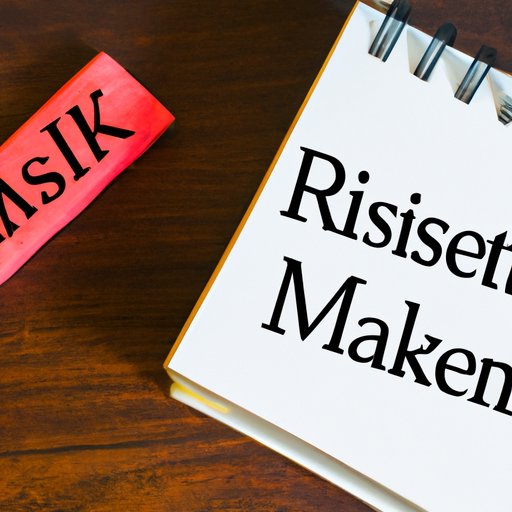
Introduction
Risk management is an essential and integral process for healthcare organizations to maintain high standards of patient safety. It involves identifying, assessing, and controlling hazards and risks that may endanger patients, visitors, and staff members. The primary goal of risk management in healthcare is to minimize the possibility of errors, accidents, and mistakes that can have catastrophic consequences. This article aims to provide healthcare professionals with a comprehensive guide to effective risk management practices.
The Importance of Risk Management for Patient Safety in Healthcare
Patient safety incidents such as medical errors, infections, and falls can have far-reaching consequences, including loss of life, pain and suffering, long-term disability, and legal action. Risk management is, therefore, crucial in mitigating these risks and ensuring patient safety. By detecting risks early on and putting measures in place to control them, healthcare organizations can avoid costly and damaging errors and provide safer care to patients.
Real-world incidents, such as the SARS outbreak and the Vioxx scandal, highlight the critical need for effective risk management in healthcare. In 2003, the SARS epidemic, which affected thousands of healthcare workers and patients in China, Canada, and Hong Kong, highlighted the importance of infection control measures and early detection of communicable diseases. Similarly, in 2004, the recall of Vioxx, a popular pain-reliever drug, due to its association with increased risk of heart attack and stroke, highlighted the importance of post-marketing surveillance and risk management in drug development and approval processes.
The Basics of Risk Management: How Healthcare Facilities Can Protect Themselves from Liability
In healthcare facilities, risk management involves identifying potential risks, analyzing them, and devising strategies to minimize and control those risks.
The first step is to identify potential hazards and risks in the healthcare setting, such as equipment malfunctions, inadequate staffing levels, medication errors, and inadequate infection control practices. This is followed by risk assessment and analysis, which involve evaluating the likelihood and severity of the identified risks and their potential impact on patient safety.
Once potential risks have been identified and analyzed, healthcare facilities can take steps to minimize and control those risks. This may include implementing policies and procedures, providing staff education and training, and deploying technology tools such as electronic health records and data analytics to identify and mitigate risks and hazards.
It is essential to carry out regular risk assessments and revisions to ensure that risk management strategies are effective and up-to-date.

Understanding Risk Management: A Guide for Healthcare Professionals
Healthcare professionals play a critical role in the risk management process. Effective risk management requires a culture of safety in which all staff members are committed to identifying and reporting potential hazards and risks.
Key principles of effective risk management include open communication, collaborative teamwork, and a focus on continuous improvement. Healthcare organizations should encourage active participation of staff members in risk management activities such as hazard identification and reporting, risk assessments, and root cause analysis.
Efforts to improve communication and collaboration amongst healthcare professionals, such as team-based training programs and interdisciplinary planning and problem-solving sessions, can greatly enhance the effectiveness of risk management strategies.
Healthcare professionals should also be trained and educated on risk management practices, including root cause analysis, incident reporting, and near-miss reporting. This education should be an ongoing process, designed to ensure that staff members are up-to-date with the latest risk management practices and procedures.
How Risk Management Impacts Quality of Care in Healthcare
Risk management is core to the delivery of quality care in healthcare settings. Effective risk management practices can contribute to the achievement of the Institute of Medicine’s six aims of quality care: safety, effectiveness, efficiency, patient-centeredness, timeliness, and equity.
Patient safety is at the heart of the risk management process. The implementation of effective risk management strategies can reduce the risk of medical errors, adverse events, and complications, resulting in safer care for patients.
By reducing the occurrence of errors and complications, healthcare facilities can also achieve greater efficiency in the delivery of care, by lowering costs associated with treatment and hospitalization. Effective risk management strategies can also enhance patient-centered care by improving patient satisfaction levels and reducing the incidence of adverse outcomes.
The Role of Technology in Risk Management for Healthcare Organizations
The integration of technology in risk management has the potential to revolutionize the healthcare industry by developing data-driven risk management approaches that can better identify, assess, and control patient safety risks.
Electronic health records (EHRs) can provide real-time access to patient data, enabling healthcare professionals to identify potential risks and hazards quickly. This data can be analyzed using data analytics tools to identify patterns and trends, which can inform risk management strategies.
The use of predictive algorithms and machine learning models can help to identify high-risk patients and predict adverse events, allowing healthcare professionals to take proactive risk management measures. However, as with any technology, there are potential limitations, such as the need for data quality and security measures to ensure the accuracy and privacy of patient data.
Top Strategies for Effective Risk Management in Healthcare Settings
Effective risk management in healthcare requires a multi-pronged approach, encompassing best practices in communication, collaboration, data analysis, and patient engagement.
Strategies that can enhance risk management in healthcare settings include:
- Improving communication and collaboration amongst healthcare professionals: This can include team-based training programs and interdisciplinary planning and problem-solving sessions.
- Implementation of data-driven risk management approaches: Healthcare facilities can deploy technology tools such as electronic health records and data analytics to identify and mitigate risks and hazards.
- Strategies for involving patients and their families in risk management practices: Such as educating them on the importance of reporting any concerns and involving them in care-planning discussions.
- Importance of continual evaluation and improvement of risk management practices: Healthcare organizations should continually assess and revise their risk management approaches to ensure they are effective and up-to-date.
Conclusion
In conclusion, risk management is an essential component of the provision of safe and effective healthcare services. Healthcare organizations that prioritize risk management are better able to protect patients, visitors, and staff members from potential hazards and risks and achieve higher standards of quality care. By adopting best practices in communication, collaboration, data analysis, and patient engagement, healthcare professionals can enhance their risk management strategies and provide safer care to patients. The future of risk management in healthcare is bright, with ongoing technological advances and increasing focus on patient safety.




